Lauren Cameo and Fiona McQueen enjoyed a new freediving experience when they visited Ardrossan jetty recently. They found hundreds of tiny sea cucumbers called Rowedota shepherdi there.

The first sighting
(Taken by Lauren Cameo)
Details can be found on Facebook at any of the following:
More seacucumbers appear
(Taken by Fiona McQueen)
There is also some YouTube video footage at https://www.youtube.com/watch?v=ly3rKczd8D4 that includes vision of the tiny sea cucumbers (at between the 3 & 4 minute marks).
A closer view of the sea cucumbers
(Taken by Lauren Cameo)
Fiona McQueen commented, “they appeared to be associated with the red coralline epiphyte (Jania micrarthrodia) on the zostera seagrass – not eating it, but perching on it and perhaps the Jania was attracting/accumulating the detritus the cucumbers were feeding on.”
Close-up shot of some of the sea cucumbers
(Taken by Fiona McQueen)
The sea cucumbers were first said to be called Rowedota shephardi but, after consulting Karen Gowlett-Holmes book “A field guide to the marine invertebrates of South Australia”, I suggested Trochodota shepherdi. I soon had to correct that, however, by saying, “Rowedota shepherdi now! It is Trochodota shepherdi in …. Karen Gowlett-Holmes book, but (it has been) changed to Rowedota shepherdi now.”

Close-up shot of a single specimen
(Taken by Finoa McQueen)
The species, as Trochodota shepherdi in “A field guide to the marine invertebrates of South Australia”, is described as ‘90mm long’, ‘delicate’, ‘very dark brown to black’, ‘lacks tube feet on body surface’, ‘uses tentacles for feeding and to move the animal along’, ‘found in sand, on sheltered to moderately exposed coats; 0-12m depth’.
The species, as Trochodota shepherdi, belongs to the family Chiridotidae, and was described by Rowe in 1976. Its CAAB code* is given as 25 432012. I was correct in guessing that the species was named after/for Dr Scoresby Shepherd. It was Dr Shepherd who had collected the first specimen from Port Lincoln in 1975.
*(A CAAB code is “the unique eight digit code number from the Codes for Australian Aquatic Biota (CAAB) maintained by the CSIRO Division of Marine and Atmospheric Research …..”.)
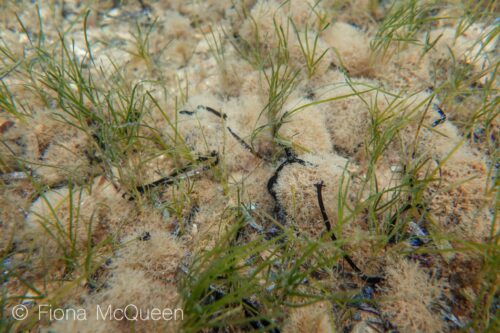
More seacucumbers
(Taken by Fiona McQueen)
At https://collections.museumsvictoria.com.au/species/16921 , Rowedota shepherdi is described as “Soft, thick, worm-like sea cucumber; uniform black with translucent body wall; 10 pelato-digitate tentacles with ~8 (3-4 pairs of) digits distally; no tube feet; body wall ossicles 6-spoked wheels with non-continuous teeth grouped in a band along all mid-interradii, S-shaped hooks (scattered) with minute spinelets; up to 8 cm long.”
Rowedota shepherdi can be found on iNaturalist.and there are a few photos of the species there.
One thing that seems to be missing in relation to Rowedota shepherdi is a common name. Our two freedivers who took the above photos of the species at Ardrossan have chosen the common name of ‘noodle sea cucumber’ for now, hence the title “New Noodle Bar At Ardrossan”.
In early 2017, Brian Saunders sent us some photos of “a few finds, most made recently near home” (Coffin Bay). We shared those photos in A Few Finds From Around Coffin Bay.
One of the photos featured a Rowedota shepherdi from Crinolin Point near Coffin Bay. We used Brian’s caption at the time – “Rowedota sp., a supposedly rare sea cucumber at present common in shallow subtidal seagrass around Crinoline Point. Length fully extended 45 mm.”
Close-up of a Rowedota shepherdi from Crinolin Point
(Taken by Brian Saunders)
My thanks go to Lauren Cameo, Fiona McQueen and Brian Saunders for their assistance with these details.
(Header photo taken by Brian Saunders)


Excellent information and great find by the free divers concerned.
Just looking at inaturalist there are no obvious records involving high population densities like this.
I’ve minimal knowledge about the genus and I don’t know if I have ever seen this species, even one of.
I’m tempted to speculate that this Ardrossan population explosion, which is probably a short-term phenomenon, is a relatively new event and may be anthropogenic for a number of potential reasons including climate change, anthropogenic disruption of predator prey balance, habitat disturbance etc
Jetties, wharves and piers anecdotally are often places where such population explosions are observed.
One example is those unusual anemones and to a lesser extent a somewhat more warm temperate to tropical holothurian I wrote about several decades ago under Port Lincoln’s town (public) jetty.
Apologies, I don’t know how to give links. The article was a MLSSA one titled “All The Way With PLJ”.
PS: on inat this species is flagged as critically endangered in Victoria, with a single RG observation from Geelong.
Thanks David, I have now updated the article to include Brian Saunders’ photo from 2017
[…] What have I learned about Rowedota shepherdi since writing New Noodle Bar At Ardrossan? […]